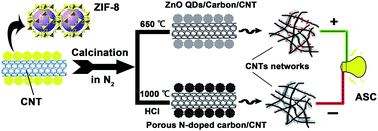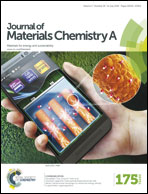All-solid-state asymmetric supercapacitors based on ZnO quantum dots/carbon/CNT and porous N-doped carbon/CNT electrodes derived from a single ZIF-8/CNT template†
Abstract
Currently, the development of two kinds of materials from a single precursor has been an important frontier in material synthesis. In this study, we have successfully fabricated a single precursor using metal–organic frameworks (MOFs) (zeolitic imidazolate framework, ZIF-8) and carbon nanotubes (CNTs). ZnO quantum dots (QDs)/carbon/CNTs and porous N-doped carbon/CNTs have been selectively synthesized from a single ZIF-8/CNTs template. When the two derived materials were used for supercapacitor electrodes, they showed high capacitance values (185 F g−1 g for ZnO QDs/carbon/CNTs at 0.5 A g−1 and 250 F g−1 g for porous N-doped carbon/CNTs at 1 A g−1, respectively). Further, an all-solid-state asymmetric supercapacitor (ASC) device using ZnO QDs/carbon/CNTs as the positive electrode and porous N-doped carbon/CNTs as the negative electrode was fabricated, and this device could reach a working potential of 1.7 V, delivering a maximum energy density of 23.6 W h kg−1 and a maximum power density of 16.9 kW kg−1, which are better than those of the ZnO-based symmetric or asymmetric supercapacitor devices.


 Please wait while we load your content...
Please wait while we load your content...